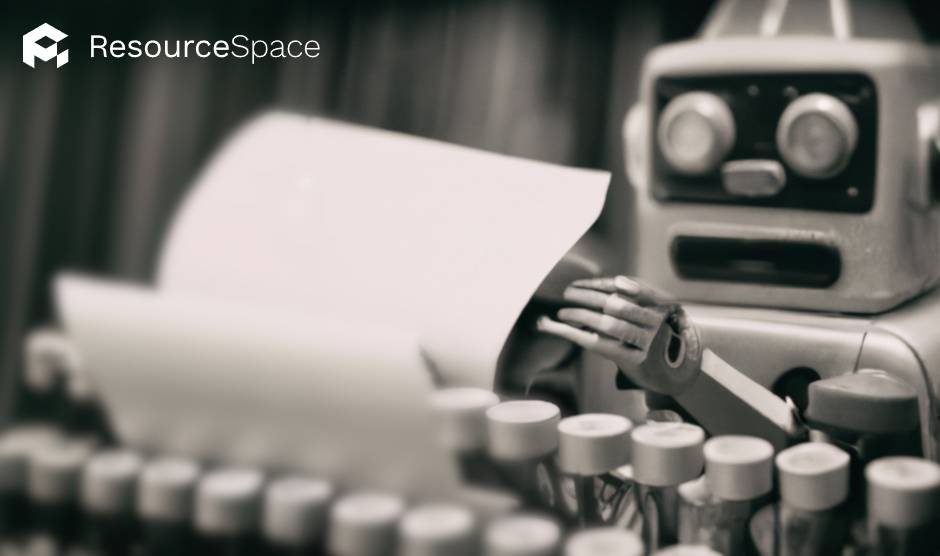
Fairtrade communications staff around the world really appreciate ResourceSpace. It's proven invaluable as a one-stop for sharing and storing all our images and brand assets. I don't know how we'd manage without it!
Blog
30th September 2022

There's a lot of chatter at the moment about AI and content marketing.
OpenAI's DALL-E 2 image software was released earlier this year, and there's now a number of AI copywriting tools that can be used for short form content, as well as whole blog posts.
However, the key question (and the question on the minds of professional graphic designers and copywriters everywhere) is whether AI represents the future of content marketing.
AI content tools are already producing some impressive stuff, but it's early days, and there are still bugs that need to be ironed out. Below are four images generated by DALL-E 2, an AI-powered tool that can turn any imagination into artwork from text, based on the prompt 'A wolf howling at the moon'.

It's pretty clear what these four images are trying to show and the results are surprisingly polished.
The best AI content writing tools aren't quite ready to replace human writers, but they can certainly make their jobs easier, and make the creative process faster. In fact, AI could become an invaluable tool for writers.
Writer's block is really frustrating as a copywriter, and it kills productivity. Getting stuck on a sentence or paragraph, or not knowing how to kick off a blog post, wastes a lot of time - but AI can help.
These AI tools are already great at generating short form content, so could be just what you need to get you out of a creative rut. In the future, AI might even be able to generate a high quality first draft of an entire blog post within minutes.
Helping with writer's block is just one way AI might speed up the writing process. AI-driven software like Grammarly and the Hemingway Editor are already making the editing process easier and faster, giving writers more time to focus on more interesting and creative things.
Another OpenAI project, GPT-3, is a natural language AI model that has been developed using a huge amount of data and information. This means AI-generated content can open up new ideas and insights that the writer simply wasn't aware of. As these tools become more sophisticated, writers will be able to draw from an ever-growing bank of knowledge.
AI content generation has come a long way in a short time - and it's hard to put a limit on AI content in the future.
AI is already able to create quality images and written content, but will it ever be able to replace humans completely?
Considering the pace of progress, it's hard to see AI not getting to the stage where computer-generated content is indistinguishable from human-generated content. However, to paraphrase Jeff Goldblum in Jurassic Park, just because it could doesn't necessarily mean it should.
Content is a form of communication between two people. Human writers are still far better at understanding the right tone for the right moment and understanding messaging nuance. That's going to be very hard for AI to match.
But what about graphic designers? Some of the most impressive progress made with AI-generated content is in imagery, so are their days numbered?
AI is great at generating multiple variations at speed and creating abstract designs, but human designers are still far better at understanding nuance and empathy. What's more, AI is still a long way away from being able to create genuinely unique content. These AI tools can analyse and process far more data than the human brain, but ultimately what they create will always be informed by existing content.
Digital Asset Management (DAM) software will use AI to automatically tag images and videos with relevant keywords, making it easier for users to search for and find the right content.
For example, facial recognition technology will be used to identify people in digital assets, making it easier to find all photos and videos featuring a particular person.
AI will also be used to improve the search functionality of digital asset management systems, making it easier for users to find the content they need.
Digital asset management systems will use AI to automatically curate content, making it easier for users to find the best and most relevant content. This will work by analysing user behaviour and identifying trends in what content is being accessed and used. Additionally, AI can be used to identify relationships between different assets, which can help users find related content more easily.
AI will be used to improve the workflow of digital asset management systems, making it easier for users to manage their content.
Digital asset management systems will use AI to provide personalised recommendations of content to users. The system will learn the user's preferences and offer content that is more likely to be of interest.
***
If you're still not convinced about the power of AI-generated content, you might be surprised to learn that the whole of the previous section, '5 ways AI will impact Digital Asset Management', was written by AI, with no human editing. Could you tell? If not, maybe AI-generated content is closer than you think.
That's not the only AI-generated piece of content in this blog post though. The featured image was created in DALL-E 2 when the phrase "A vintage photograph of a robot using a typewriter. Close up shot." was entered.
ResourceSpace has been using AI for some time to assist with automated metadata tagging. The recognition tool will identify objects, faces places and logos in digital assets and recommend appropriate keywords. What's more, any identified text will be mapped to a separate field. The facial recognition function will even pick up on specific people, as ResourceSpace learns from existing tagged faces.
Want to find out more about ResourceSpace? Book your free demo, or launch a free DAM portal within minutes below.
#AI
#ContentMarketing
#OpenAI
#DALL
-E2 #Copywriting
#GraphicDesign
#IndustryNews
#ArtificialIntelligence
#CreativeProcess